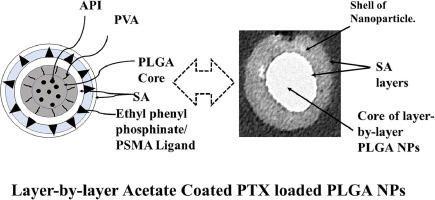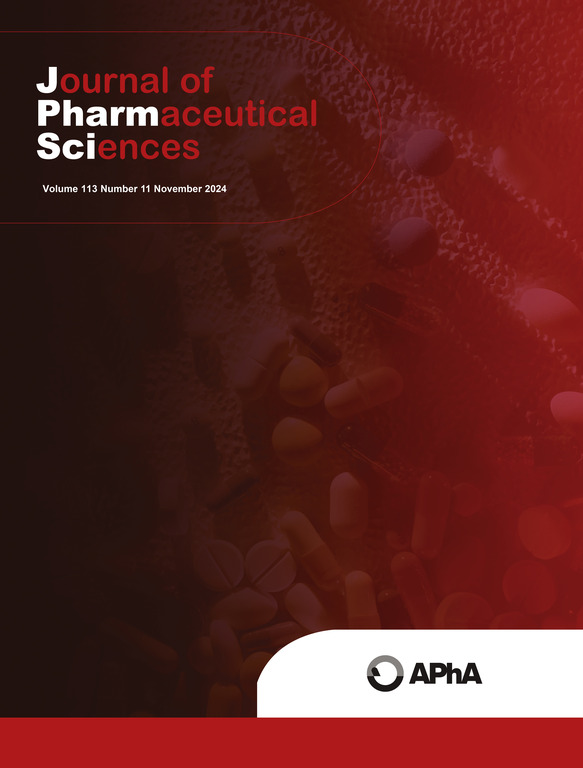Engineering of layer-by-layer acetate-coated paclitaxel loaded poly(lactide-co-glycolide) acid nanoparticles for prostate cancer therapy- in vitro
IF 3.7
3区 医学
Q2 CHEMISTRY, MEDICINAL
引用次数: 0
Abstract
It is hypothesized that layer-by-layer acetate-coated Paclitaxel-loaded PLGA nanoparticles (F2) can be engineered to potentiate the effectiveness of Paclitaxel (PTX) on LNCaP, a human prostate cancer cell line. The core of the layer-by-layer NPs is formed by nanoprecipitation, and the shell of the NPs is engineered using the sodium acetate's unique coating mechanism and surface-active properties. The resulting nanoformulation physicochemical properties are characterized by Fourier Transform Infra-Red (FTIR), Differential Scanning Calorimetry (DSC) Transmission Electron Microscopy (TEM), NanoSight NS300, spectrophotometry, Korsmeyer-Peppas model, respectively. The NP's cytotoxicity on LNCaP is assessed by MTS assay. The DSC and the FTIR confirm SA's coating of the NPs. The particle's mean diameters (PMD) are 89.4±2.3- to 114.4±7.6 nm. The TEM shows a unique multilayer and spherical nanoparticle. The encapsulation efficiency of commonly PTX-loaded PLGA NPs (F1) and F2 are 84.37±2.71% and 86.74±2.22, respectively. The drug transport mechanism of F1 and F2 is anomalous transport and case II, respectively. F2 follows a zero-order release mechanism. The cell viability is 45.08±2.18% and 60.17±4.72% when LNCaP is treated with 10 µg/mL of F2 and F1, respectively, after 48 hours of exposure. F2 and F1 cell growth inhibition are dose-dependent. This unique process of engineering the layer-by-layer NPs will provide new horizons for developing future innovative nanoparticles for targeted prostate cancer therapy.

用于前列腺癌治疗的逐层醋酸纤维包覆紫杉醇聚乳酸-共聚甘醇酸纳米粒子的体外工程学研究
该研究假设,逐层醋酸钠包覆的紫杉醇负载PLGA纳米粒子(F2)可增强紫杉醇(PTX)对人类前列腺癌细胞系LNCaP的疗效。逐层 NPs 的核心是通过纳米沉淀形成的,而 NPs 的外壳则是利用醋酸钠独特的涂层机制和表面活性特性设计的。傅立叶变换红外光谱法(FTIR)、差示扫描量热法(DSC)、透射电子显微镜(TEM)、NanoSight NS300、分光光度法、Korsmeyer-Peppas 模型分别对所制备的纳米制剂的理化性质进行了表征。NP 对 LNCaP 的细胞毒性通过 MTS 试验进行评估。DSC 和傅立叶变换红外光谱证实了 NPs 上的 SA 涂层。颗粒的平均直径(PMD)为 89.4±2.3- 至 114.4±7.6 nm。TEM 显示了独特的多层球形纳米粒子。常见的PTX负载PLGA NPs(F1)和F2的包封效率分别为84.37±2.71%和86.74±2.22。F1和F2的药物转运机制分别为反常转运和情况II。F2 遵循零阶释放机制。用 10 µg/mL 的 F2 和 F1 处理 LNCaP 细胞 48 小时后,细胞存活率分别为 45.08±2.18% 和 60.17±4.72%。F2 和 F1 对细胞生长的抑制具有剂量依赖性。这种独特的逐层 NPs 工程工艺将为开发未来用于前列腺癌靶向治疗的创新纳米粒子提供新的前景。
本文章由计算机程序翻译,如有差异,请以英文原文为准。
求助全文
约1分钟内获得全文
求助全文
来源期刊
CiteScore
7.30
自引率
13.20%
发文量
367
审稿时长
33 days
期刊介绍:
The Journal of Pharmaceutical Sciences will publish original research papers, original research notes, invited topical reviews (including Minireviews), and editorial commentary and news. The area of focus shall be concepts in basic pharmaceutical science and such topics as chemical processing of pharmaceuticals, including crystallization, lyophilization, chemical stability of drugs, pharmacokinetics, biopharmaceutics, pharmacodynamics, pro-drug developments, metabolic disposition of bioactive agents, dosage form design, protein-peptide chemistry and biotechnology specifically as these relate to pharmaceutical technology, and targeted drug delivery.

 求助内容:
求助内容: 应助结果提醒方式:
应助结果提醒方式:


